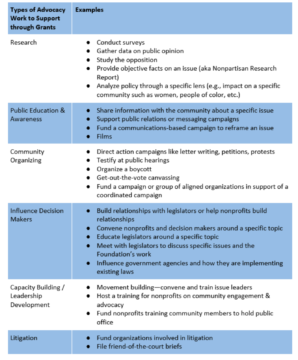What is Giving Compass?
We connect donors to learning resources and ways to support community-led solutions. Learn more about us.
Search our Guide to Good
Start searching for your way to change the world.
Advocacy and policy work are crucial elements of democracy, and philanthropy can help drive progress toward meaningful changes to advance democratic processes. Learn how:
- Why Strategic Philanthropy Needs Advocacy, Arabella Advisors
Philanthropists will need to work closely with advocates to achieve scale. - How To Strengthen Philanthropy’s Role In Policy Work, Philantopic
Investing in policy change is one way of achieving a funder's social justice goals. - The Fundamental Questions Behind Advocacy Work, GuideStar
The field has made a lot of progress over the past decade in terms of thinking about how to approach advocacy evaluation. Here are some basic questions to help funders get started on advocacy campaigns. - Four Promising Practices for Philanthropies to Advance Advocacy and Policy Change, Center for Effective Philanthropy
Funders are increasingly turning to policy advocacy as a lever for change. Here are four practices that donors can incorporate when funding advocacy. - The Women’s Foundation of California, and its Philanthropy and Public Policy Institute, engages funders in coursework that strengthens their knowledge and understanding of critical concepts in philanthropy and policy.

The Women's Foundation of California
Advocacy Collaboratives
While a small number of family foundations engage in advocacy work, growing civic engagement has led to more funders coming to the table. Here's a look at advocacy collaboratives:
- Collaboration Is All The Rage, But Many Still Hesitate About Advocacy, Philantopic
GrantCraft by Candid interviewed advocacy stakeholders to understand why advocacy collaboratives are effective:- Advocacy collaboratives focus on very specific goals.
- They flex and adapt.
- Policy advocacy collaboratives also continually tweak their strategies to align with the changing political, economic, and social context.
- They embrace complexity.
- They acknowledge and embrace risk.
- Four Tips To Strengthen Advocacy Relationships, GrantCraft by Candid
- Be intentional about asking whether and how organizations can be involved in the collaborative’s work at each point in the process.
- But don't always just ask for input.
- Be transparent about the collaborative’s process, criteria, and grant decisions.
- Check on the loyalties.
- The Benefits of Being Part of An Advocacy Collaborative, GrantCraft by Candid
A group of colleagues, field leaders, and other experts can unite around a common cause through advocacy collaboratives, and that can lead to greater impact in the sector.
- Collaboration Is All The Rage, But Many Still Hesitate About Advocacy, Philantopic
Individual funders also believe their grantmaking is improved because the information shared through the advocacy collaborative is more comprehensive, timely, and rich.
To understand more about advocacy funder collaboratives, Grantcraft by Candid has compiled a suite of resources for donors.
An important part of advocacy work is ensuring the communities that donors are trying to help are actually included in the conversation. The Center for Effective Philanthropy tackles the topic of feedback to inform advocacy efforts.
Taking Action in Advocacy: How to Get Started
- Making Advocacy a Family Affair, by National Center for Family Philanthropy (NCFP)
Funders may be hesitant to fund advocacy work because they feel that their impact may be difficult to measure, but NCFP offers evaluation criteria to make it easier.
Not sure where to start? The National Center for Family Philanthropy shares these opportunities for advocacy work:

Categories:
- Advocacy and Policy
- North America
- Philanthropy (Other)